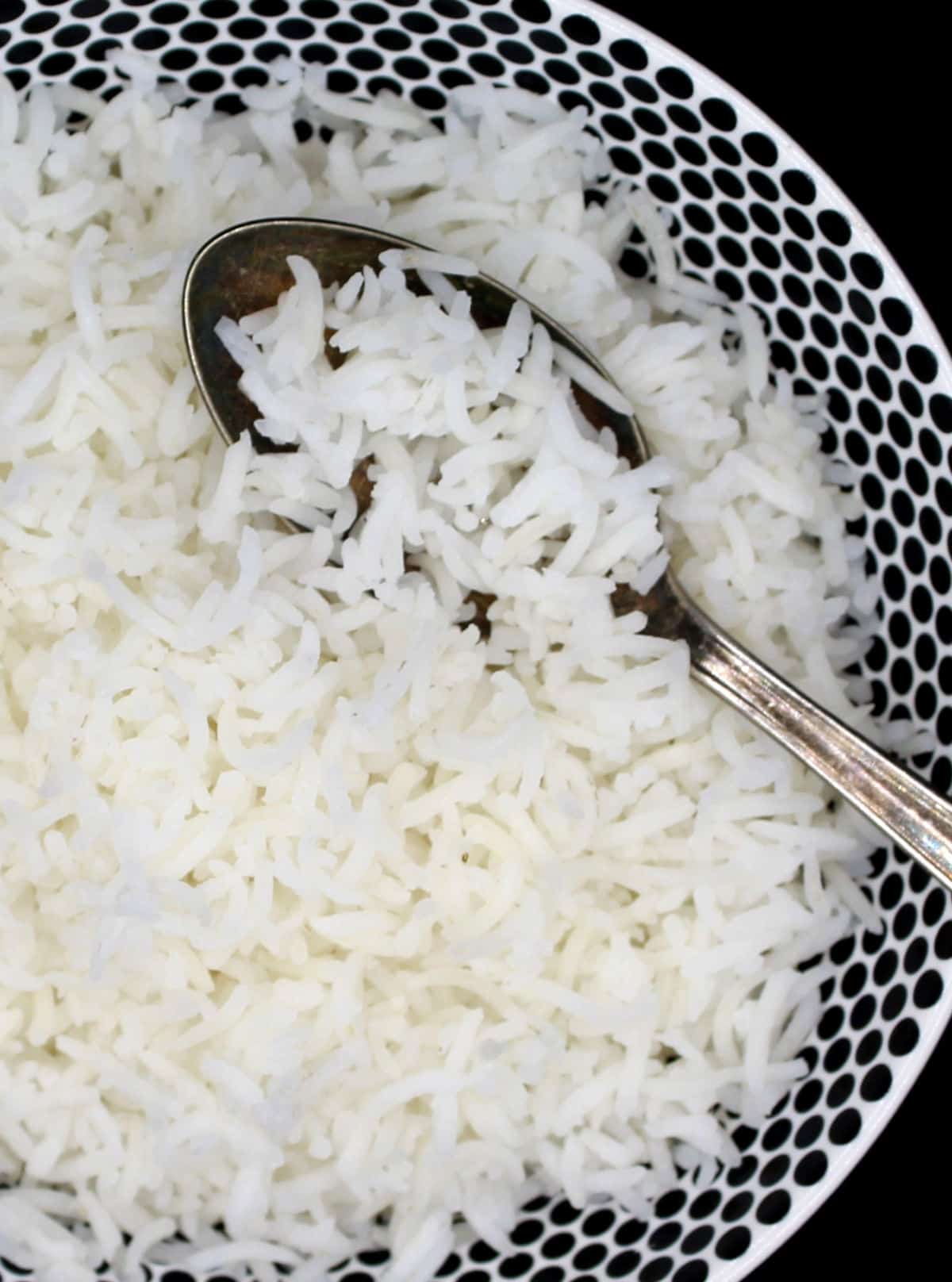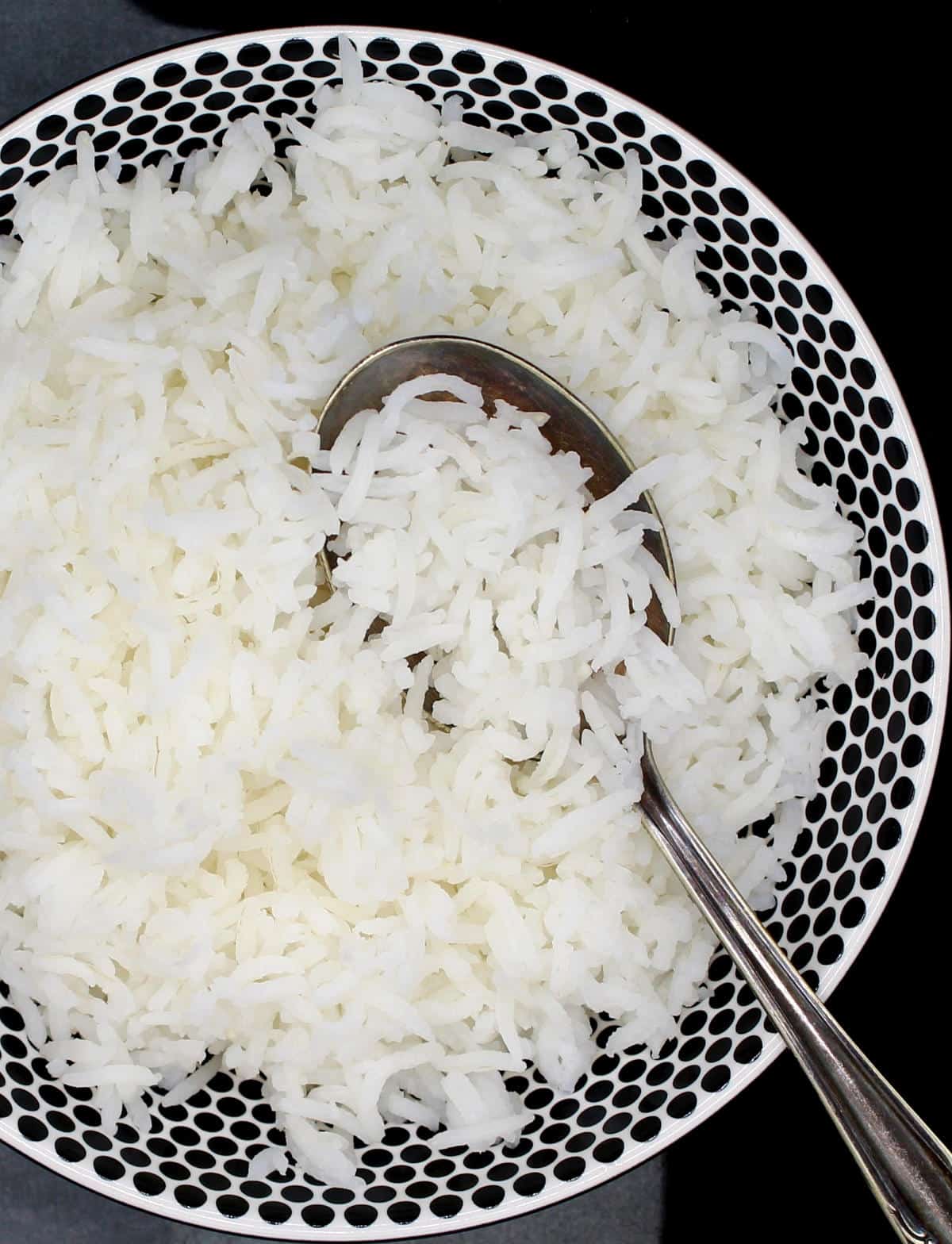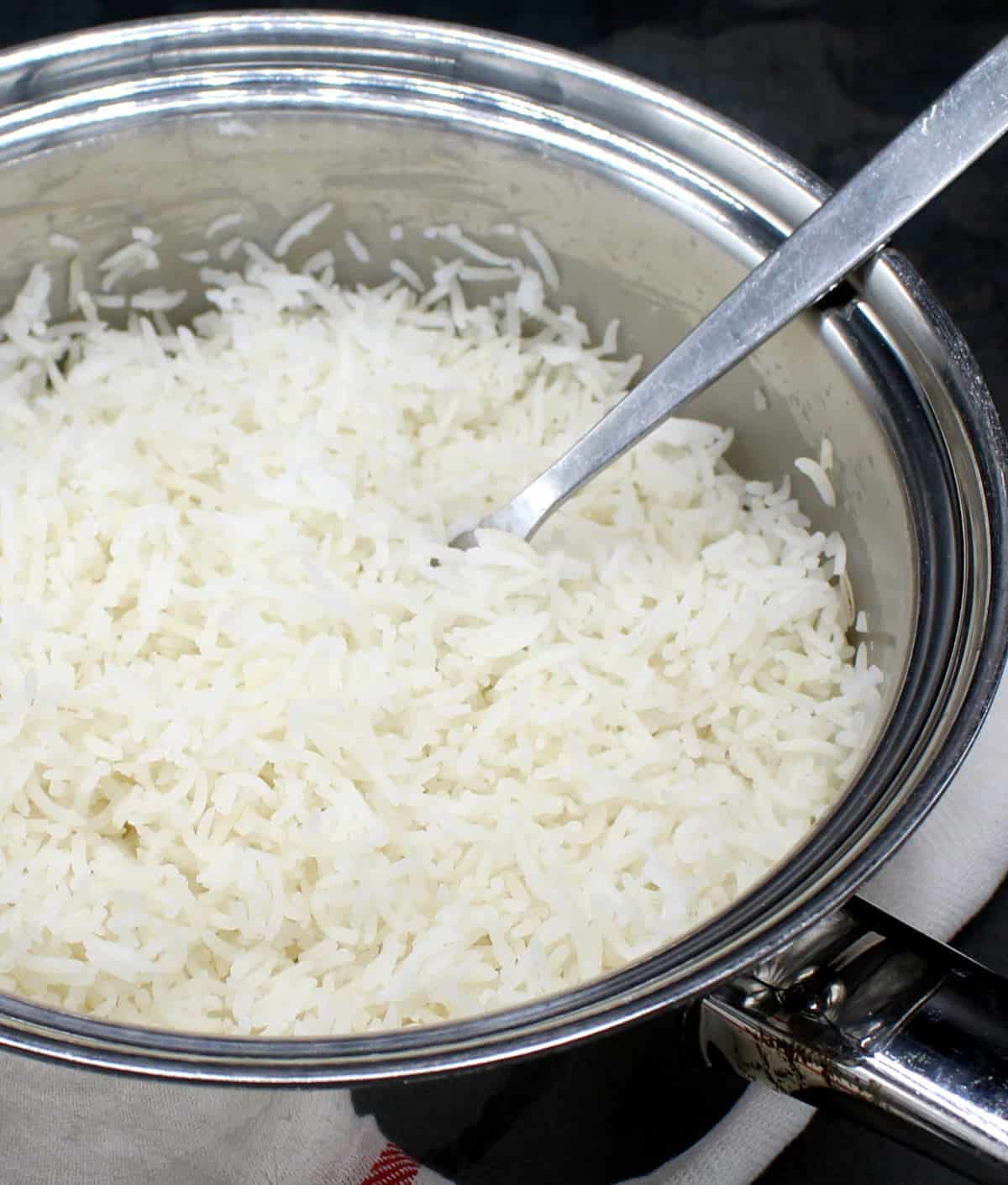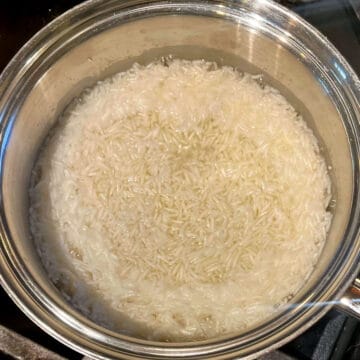A complete guide to cooking basmati rice, the long-grain and aromatic Indian rice that makes rice dishes like biryani, pulao and tehri even more delicious. Learn how to cook basmati in a saucepan, in the Instant Pot and in the microwave, and the exact rice to water ratios that will yield fluffy, aromatic, slender grains of rice. We'll also cover how to cook rice without soaking, after a simple rinse, and after soaking for 30 minutes. Be sure to pin this article or bookmark it for future reference!

Whether you are a seasoned cook who sometimes struggles with sticky basmati rice that clumps together, or a newbie just learning to cook, you can rest assured you will be making perfect rice each and every time with the tips and tricks we have for you today.
Basmati has long been a prized rice in India, with a name that, in Sanskrit, aptly means "filled with fragrance." Learning to cook the perfect pot of basmati rice can put you in control when it comes to turning out rice dishes like biryani and pulao. Basmati, served on its own and without any additions, also makes a great side dish with dals, stews and curries.
Like wine, basmati gets better with age. Aging improves the aroma of the rice and it also helps dry the rice fully, which keeps grains separate and fluffy when they cook.
Frequently asked questions
Not rinsing or soaking rice: Rice grains are full of starch and there is often a lot of starch sticking to the outside of the individual grains because they rub against each other in the bag. Starch becomes gummy when cooked, causing the rice grains to clump together. When you rinse out that excess starch from the rice, you automatically reduce all chances of clumping.
Adding too much water: You need the perfect rice to water ratio when cooking basmati rice--or any other rice--and that changes according to the medium of cooking. If you were to cook rice in the Instant Pot you'd need less water than if you were cooking it on the stove. If you cook rice in the microwave you'd need more.
Overcooking the rice: Cooking rice for too long makes the grains break down and become starchy, which in turn will result in gummy rice.
Stirring the rice after it is cooked but before it has had a chance to rest: You need to give the rice a few minutes to sit after cooking is complete, because it will continue to steam during this time and finish cooking. If you begin stirring the rice with a heavy ladle during or immediately after cooking you will likely break the delicate cooked grains, causing them to become sticky.
You don't absolutely need to soak the rice before cooking it, and I will show you how you can make great rice without rinsing or soaking. That said there are many benefits to soaking the rice: soaked rice will yield rice grains that are longer and slender and more attractive. You will also nearly halve the cooking time. The shorter cooking time also preserves the aroma of the rice, which dissipates the longer you cook it.
Rinsing the rice will also yield a longer grain rice, although the result won't be as good as the soaked rice.
Undercooked rice results from too little water or cooking the rice over very high heat, which will lead to quick moisture loss. Eating undercooked rice can also cause health problems, especially damage to the digestive tract. Make sure to use proper rice to water ratios and also stir the rice once halfway through cooking to make sure all rice grains have a chance to absorb the water.
A cup of basmati rice will make approximately three cups of fluffy, cooked rice. That is enough for four hearty servings.
Basmati rice has some health advantages over other types of white rice, the main one being its lower glycemic index. White rice has a glycemic index of 72 but basmati has a glycemic index between 50 and 58, meaning it is less likely to cause blood sugar to rise. Wholegrain or brown basmati rice has an even lower glycemic index.
A cup of cooked basmati rice contains 210 calories.
For everyday use, I buy the 20-pound bags of Royal basmati from Costco. I really like it and it works well on a budget. For more fancy preparations I buy a more expensive variety from the Indian grocery store, like Tilda or Daawat. These are more aromatic and have a longer grain, but the difference is not huge. You can save your money if you'd rather not have two different varieties of basmati rice in your pantry and just go with the Royal.
Ingredients
- Rice
- Water
How to cook basmati rice on the stove
No-soak method
- You will need a 1:2 rice to water ratio for the no-soak method.
- Place 1 cup of rice, without rinsing, in a saucepan with 2 cups water. Bring to a boil over medium heat.
- Stir the rice once, place a tight lid over the saucepan, lower heat to the lowest setting on your stove, and cook the rice for 15 minutes. Halfway through cooking, open the lid and stir the rice gently for the last time. This ensures that the rice on top doesn't remain hard and undercooked.
- Cover the saucepan. After the rice has finished cooking, resist the temptation to open the saucepan and peek. Let it stand 15 minutes, then gently fluff the rice with a fork to separate the grains.
Rinsing method

- For this method you need a 1:1 ¾ths rice to water ratio.
- Place a cup of rice in a colander and hold it under cold running water for a minute or two, gently moving it around with your hand, until the water runs mostly clear.
- Place the rice in a saucepan with 1 ¾ths cup water. Bring to a boil, then cover and set the timer for 12 minutes.
- Halfway through, at the six-minute mark, stir the rice gently. Cover and let it continue cooking.
- Once cooking is complete let the rice stand at least 10-15 minutes without peeking. Then remove the lid and fluff the rice grains with a fork before serving.
Soaking method

- For this method you need a 1:1 ¼ cups rice to water ratio.
- Place a cup of rice in a bowl covered with two inches of cold water. Let the rice soak 30 minutes.
- Transfer the rice to a colander and rinse it for a few seconds, moving the rice grains around with your hand to get any remaining starch out. The rice grains have absorbed some water and are tender at this point so be gentle as they can break!
- Place the rice in a saucepan with 1 ¼ths cup water. Bring to a boil over medium heat, then cover and cook 8 minutes. Stir gently halfway through. After cooking is complete let the rice stand 15 minutes. Then fluff the rice grains gently with a fork.
How to cook basmati rice in the Instant Pot
- For this method you need a 1: 1 ¼ cups rice to water ratio.
- Place the unrinsed basmati rice in the IP liner or in a separate IP-safe container (I use these stackable inserts so I can cook lentils and veggies at the same time, saving on energy)
- Pressure cook for 8 minutes, then wait for 10 minutes for the pressure to release naturally or force-release.
- Fluff grains with fork before serving.
How to cook basmati rice in the microwave
- This method will need a 1:2 cups rice to water ratio.
- Place a cup of unrinsed rice in a microwave-safe bowl with 2 cups water.
- Microwave on high for 12 minutes. Let the rice stand 10 minutes in the microwave, then fluff the rice gently with a fork before serving.
Variations
- Biryani rice: To cook the perfect rice for biryani, you need the rice to be only about 80 percent cooked and quite al dente, because it will continue to cook with the biryani masala. Use the soaking method to make biryani rice and reduce the quantity of water to 1 cup.
- Rice for pulao or fried rice: For a pulao, like this navratan pulao, or fried rice, you need the rice to be nearly cooked but it needs to be firm enough that it won't gum together in the wok. Cook the rice using the rinsing method and cook the rice for 10 minutes instead of 12. For fried rice spread the rice out on a cookie sheet and let any residual water evaporate before adding it to the wok.
- Cumin rice. I make cumin rice using the no-soak method. You can see the recipe for cumin rice, or jeera rice, here.
- Rice for stews. It's not a good idea to add oil or butter to rice you will use in biryanis and pulaos because the oil slick on the rice keeps it from absorbing other flavors. If you are serving basmati rice alongside a stew, however, you can add a tablespoon of vegan butter to the water when cooking, along with a bit of salt, to add flavor.
- With stock: You can replace the water with vegetable stock or mushroom stock for an even more flavorful and aromatic rice that goes nicely with stews.

Dals to serve with basmati rice
Curries to serve with basmati rice
- Chickpea curry
- Zucchini kofta curry
- Vegan butter chicken
- Vegan "chicken" masala
- My dad's "not-mutton" mushroom curry
Storage instructions
- Refrigerate: Cooked basmati rice will keep in the fridge for up to three days.
- Freeze: Place cooked rice in a thin layer on a cookie sheet immediately after cooking and let it cool down in the fridge. Scoop it into a freezer-safe bag or container and freeze up to four months.
- Reheat: Add a tablespoon of water for every cup of rice and reheat on the stovetop for 3-5 minutes, stirring gently to make sure nothing sticks. You can also do this in the microwave. Add a tablespoon of water for each cup of rice and microwave on high for one to two minutes.


Basmati Rice
Equipment
-
Saucepan with lid OR
-
Instant Pot OR
-
microwave safe bowl
Instructions
No-soak stovetop method (1: 2 cups rice to water ratio)
-
Place 1 cup of rice, without rinsing, in a saucepan with 2 cups water. Bring to a boil over medium heat. Stir the rice once, place a tight lid over the saucepan, lower heat to the lowest setting on your stove, and cook the rice for 15 minutes. Halfway through cooking, open the lid and stir the rice gently for the last time. This ensures that the rice on top doesn't remain hard and undercooked. Cover the saucepan. After the rice has finished cooking, resist the temptation to open the saucepan and peek. Let it stand 15 minutes, then gently fluff the rice with a fork to separate the grains.
Rinsing stovetop method (1: 1¾ cups rice to water ratio)
-
Place a cup of rice in a colander and hold it under cold running water for a minute or two, gently moving it around with your hand, until the water runs mostly clear. Place the rice in a saucepan with 1 ¾ths cup water. Bring to a boil, then cover and set the timer for 12 minutes. Halfway through, at the six-minute mark, stir the rice gently. Cover and let it continue cooking. Once cooking is complete let the rice stand at least 10-15 minutes without peeking. Then remove the lid and fluff the rice grains with a fork before serving.
Soaking method for stovetop (1: 1¼ cups rice to water ratio)
-
Place a cup of rice in a bowl covered with two inches of cold water. Let the rice soak 30 minutes.Transfer the rice to a colander and rinse it for a few seconds, moving the rice grains around with your hand to get any remaining starch out. The rice grains have absorbed some water and are tender at this point so be gentle as they can break! Place the rice in a saucepan with 1 ¼ths cup water. Bring to a boil over medium heat, then cover and cook 8 minutes. Stir gently halfway through. After cooking is complete let the rice stand 15 minutes. Then fluff the rice grains gently with a fork.
Instant pot method (1: 1¼cups rice to water ratio)
-
Place the unrinsed basmati rice in the IP liner or in a separate IP-safe container. Pressure cook for 8 minutes, then wait for 10 minutes for the pressure to release naturally or force-release. Fluff grains with fork before serving.
Microwave method (1:2 cups rice to water ratio)
-
Place a cup of unrinsed rice in a microwave-safe bowl with 2 cups water. Microwave on high for 12 minutes. Let the rice stand 10 minutes in the microwave, then fluff the rice gently with a fork before serving.
Notes
- Biryani rice: To cook the perfect rice for biryani, you need the rice to be only about 80 percent cooked and quite al dente, because it will continue to cook with the biryani masala. Use the soaking method to make biryani rice and reduce the quantity of water to 1 cup.
- Rice for pulao or fried rice: For a pulao or fried rice, you need the rice to be nearly cooked but it needs to be firm enough that it won't gum together in the wok. Cook the rice using the rinsing method and cook the rice for 10 minutes instead of 12. For fried rice spread the rice out on a cookie sheet and let any residual water evaporate before adding it to the wok.
- Cumin rice. I make cumin rice using the no-soak method. You can see the recipe for cumin rice, or jeera rice, here.
- Rice for stews. It's not a good idea to add oil or butter to rice you will use in biryanis and pulaos because the oil slick on the rice keeps it from absorbing other flavors. If you are serving basmati rice alongside a stew, however, you can add a tablespoon of vegan butter to the water when cooking, along with a bit of salt, to add flavor.
- Refrigerate: Cooked basmati rice will keep in the fridge for up to three days.
- Freeze: Place cooked rice in a thin layer on a cookie sheet immediately after cooking and let it cool down in the fridge. Scoop it into a freezer-safe bag or container and freeze up to four months.
- Reheat: Add a tablespoon of water for every cup of rice and reheat on the stovetop for 3-5 minutes, stirring gently to make sure nothing sticks. You can also do this in the microwave. Add a tablespoon of water for each cup of rice and microwave on high for one to two minutes.
Nutrition
The post Basmati Rice. How to Cook Perfect Basmati Rice appeared first on Holy Cow Vegan.
The post Basmati Rice. How to Cook Perfect Basmati Rice appeared first on Holy Cow Vegan.



0 Comments